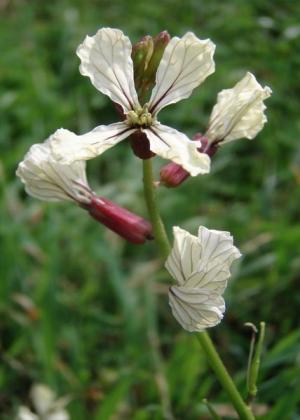Wild Radish

Wild radish (Raphanus raphanistrum) is a herbaceous annual or biennial plant similar in appearance to many other mustards. Native to Asia (or, according to some authorities, the Mediterranean), it has been introduced into most parts of the world, and is now regarded as a damagingly invasive species by most authorities. The plant grows an erect stem 1 to 3 feet tall. The leaves are lanceolate to elliptic, 1-4 inches long, with an entire to coarsely toothed margin. The flowers are attractive, four-petalled, 15-20 mm across and vary in color, usually from white to purple but sometimes light orange to yellow, often with color shading within a single petal. The fruit is a slender cylindrical capsule containing several small, dark brown seeds.
The plant contains contains large quantities of glucosinolates, which release ally lisothiocyanate upon hydrolysis. Ally isothiocyanate, is a potent irritant that has also shown fetotoxic and carcinogenic effects in laboratory rats. Most sources list the seeds as being the most toxic portion of the plant. Perhaps more dangerous than the actual chemicals the plant produces is the fact that these plants readily absorb, accumulate, and store environmental toxins, such as pesticides and nitrates. Toxins which are then passed onto the animal that chooses to ingest the plant.
The overall threat to livestock posed by these plants is low, as most animals find them to be relatively unpalatable. As a result they will typically ignore them unless other food sources are limited. Due to the weedy nature many plants of this genus possess they can, however, infest pastures, choking out other non toxic plants; essentially forcing themselves on grazing animals and thus becoming the bulk of their diet. Poisonings occur most commonly as the result of contaminated hay.
Avoid further ingestion of the plant and consult a veterinarian. Life threatening intoxication is exceedingly rare, fatalities, while theoretically possible are basically unheard of. Due to the limited amount that animals are likely to consume, serious intoxication is rare and in most cases ingestion will only result in mild to moderate gastrointestinal disturbance. In regards to a specific treatment regimen, common sense symptomatic care will probably be all that is required. If the ingestion was recent remove any existing plant matter from the mouth and flush thoroughly with water. If vomiting does not occur it may be induced by giving and emetic such as 3% hydrogen peroxide orally at a dose rate of 1 teaspoon per 10 lbs of body weight. The pet (dogs and cats) will more than likely start vomiting spontaneously without the help of an emetic, as their body tries to expel this non digestible material. The universal antidote, activated medical charcoal may also prove to be of some use in absorbing the toxins.
Ensure the pet gets plenty of fluids to avoid possible dehydration caused by diarrhea. To alleviate the gastrointestinal upset and diarrhea; Kapectolin may be given at a dose rate of 1 to 2 ml/kg four times a day. Kapectolin provides a coating action that protects the stomach lining. Sucralfate may also be used as for gastrointestinal irritation as it reacts with the acids in the stomach to form a paste-like material capable of acting as a barrier between the stomach and its contents. Sucralfate is typically given to dogs weighing more the 60lbs: 1g every 6 to 8 hours; for dogs under 60 lbs: 0.5g every 6 to 8 hours; Cats: 0.25g every 8 to 12 hours to reduce irritation of the stomach and intestines. The prognosis is generally excellent, provided the animal is not suffering the ill effects of environmental toxins that were stored in the plant. With symptomatic care most animals will make a full recovery in a few hours to a few days.




